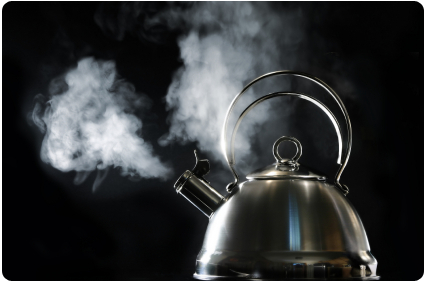Simple is Beautiful
The beauty of steam is in its simplicity. Physicists have yet to find a more efficient agent for energy transfer, which makes steam ideal for sterilization. We will now try to explain how this happens and why it's such a powerful agent for energy transfer.
Vapor
Water at any temperature will slowly but surely evaporate and become a gas. This is a natural process that happens because of the movement of the water molecules. But when water is heated and reaches 100 degrees Celsius this process intensifies and the water evaporates at a much higher rate than before, and not only on the surface but also within the water. The vapor is visible as bubbles that rise from inside the water to the surface and escape into the air. This vapor is called steam. What actually happens is that the water expands in volume by 1,600 times when it changes into steam!!

Steam vapor is invisible; notice that near the spout you can hardly see anything. The clouds we see are the steam condensate, the drops of water that form when steam hits the cooler air.
Condensation
A common mistake is to confuse the clouds of water coming out of a boiling kettle with steam. Steam is an invisible gas. What we actually see are the tiny drops of water that form when the invisible steam comes into contact with the colder air. The steam condenses and turns back into water again, which is what we see.
Condensation and Vaporization are opposites! The same heat energy that's required for evaporation is released during condensation.
When vapor hits the surface of a colder object, the heat energy is transferred from the steam to that colder object heating it up. Steam used in sterilization is hot enough that when it comes into contact with the sterilization load (colder object) and condenses, it transfers enough heat energy to kill all the bacteria on the load. This is one reason why steam is such an effective agent for sterilization.
Saturated Steam - It's a Delicate Balance
Saturated steam is called saturated because the space cannot contain more gaseous water (steam). As soon as the temperature drops the vapor will condense back into water. Saturated steam has between 3% to 5% of water and this moisture helps destroy microorganisms at a considerably lower temperature when compared to dry heat and much faster than when moisture is absent.
Deep Steam Penetration
Water vapor transfers heat much more efficiently than dry air. If we can understand why, we will understand why steam is a much more efficient sterilization agent when compared to dry heat. In our previous post we discussed how coagulation starts at a much lower temperature than oxidation. Dry heat sterilization is an oxidation method for killing microorganisms, which put simply, is burning them. But it doesn't end at that, moisture is also a carrier of heat and causes coagulation which kills microorganisms. The amount of moisture in a microorganism also influences the ease of its destruction. Microorganisms that contain more water are killed more easily by heat because moisture transfers heat energy into the microorganism more effectively than dry heat. Spores for example, are considerably dry and therefore take longer to sterilize, but the moist environment that steam provides is significantly faster and more effective for sterilization than dry heat, which makes it ideal for the destruction of spores.
The penetration of steam is deep because it has an ability to condense: When vapor condenses into water, 1,600 liters of steam condense into 1 liter of water. This huge reduction in volume causes a strong suction, which makes sterilization highly effective, because it sucks even more steam towards the colder object being sterilized. This is why steam can penetrate so powerfully and deeply into various load types, textiles and porous loads.
A summary of the main advantages of saturated steam are:
- The presence of some humidity, usually 3%-5%, in steam increases the killing effect of microorganisms, because coagulation starts at the low temperature of 52°C.
- The moisture inside the cell of a microorganism makes it easier to kill
- As soon as steam hits a cooler object that needs to be sterilized it will condense to water and release a great amount of heat
- The change of volume when steam condenses causes suction that draws more steam, which dramatically improves penetration depth
- The relation between temperature and pressure of saturated steam makes it easy to control
With all these advantages of steam, it's easy to understand why it's the most common and efficient sterilization agent. The next post will examine what happens when steam is superheated or when it becomes wet and why these two states are not ideal when sterilizing.
